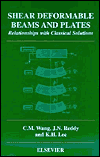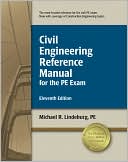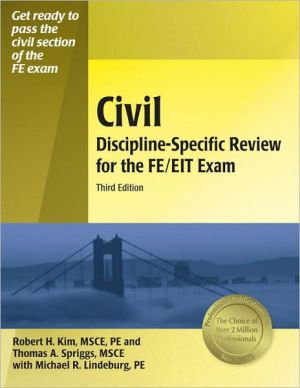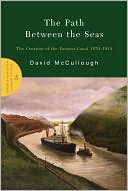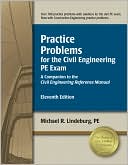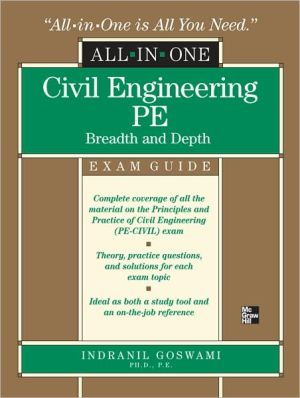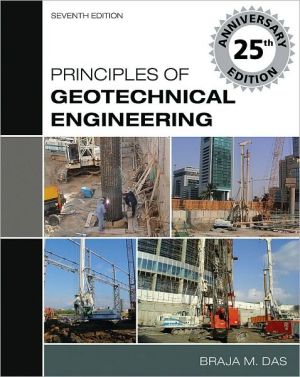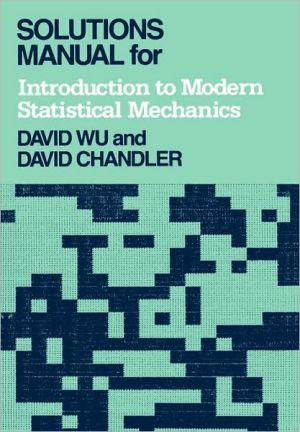Shear Deformable Beams and Plates: Relationships with Classical Solutions
Most books on the theory and analysis of beams and plates deal with the classical (Euler-Bernoulli/Kirchoff) theories but few include shear deformation theories in detail. The classical beam/plate theory is not adequate in providing accurate bending, buckling, and vibration results when the thickness-to-length ratio of the beam/plate is relatively large. This is because the effect of transverse shear strains, neglected in the classical theory, becomes significant in deep beams and thick...
Search in google:
Most books on the theory and analysis of beams and plates deal with the classical (Euler-Bernoulli/Kirchoff) theories but few include shear deformation theories in detail. The classical beam/plate theory is not adequate in providing accurate bending, buckling, and vibration results when the thickness-to-length ratio of the beam/plate is relatively large. This is because the effect of transverse shear strains, neglected in the classical theory, becomes significant in deep beams and thick plates. This book illustrates how shear deformation theories provide accurate solutions compared to the classical theory. Equations governing shear deformation theories are typically more complicated than those of the classical theory. Hence it is desirable to have exact relationships between solutions of the classical theory and shear deformation theories so that whenever classical theory solutions are available, the corresponding solutions of shear deformation theories can be readily obtained. Such relationships not only furnish benchmark solutions of shear deformation theories but also provide insight into the significance of shear deformation on the response. The relationships for beams and plates have been developed by many authors over the last several years. The goal of this monograph is to bring together these relationships for beams and plates in a single volume. The book is divided into two parts. Following the introduction, Part 1 consists of Chapters 2 to 5 dealing with beams, and Part 2 consists of Chapters 6 to 13 covering plates. Problems are included at the end of each chapter to use, extend, and develop new relationships. Booknews Because the classical Euler-Bernoulli/Kirchoff theories do not provide very good analysis of shear deformity in beams and plates in which the thickness-to-length ratio is relatively large, Wang (civil engineering, National U. of Singapore), J. N. Reddy (mechanical engineering, Texas A&M U.-College Station) and K. H. Lee (mechanical and production engineering, National U. of Singapore) describe shear deformation theories that are much more accurate. However, these theories are also much more complicated, so they, synthesizing the work of researchers over the past few years, also show relationships between the findings of the two approaches, allowing shear deformation results to be obtained from the results of classical theories. Annotation c. Book News, Inc., Portland, OR (booknews.com)
Prefacexiii1Introduction11.1Preliminary Comments11.2An Overview of Plate Theories31.3Present Study5Problems6Part 1Beams2Bending of Beams112.1Beam Theories112.1.1Introduction112.1.2Euler--Bernoulli Beam Theory (EBT)142.1.3Timoshenko Beam Theory (TBT)172.1.4Reddy--Bickford Beam Theory (RBT)202.2Relationships Between EBT and TBT242.2.1General Comments242.2.2Simply Supported (SS) Beams252.2.3Clamped-Free (CF) Beams252.2.4Free-Clamped (FC) Beams252.2.5Clamped-Simply Supported (CS) Beams262.2.6Simply Supported-Clamped (SC) Beams262.2.7Clamped (CC) Beams262.2.8Summary of Relationships272.3Relationships Between EBT and RBT282.4Examples312.4.1Simply Supported Beam322.4.2Cantilever Beam342.5Summary36Problems373Shear-Flexural Stiffness Matrix393.1Introduction393.2Summary of Relationships413.2.1Relationships Between TBT and EBT413.2.2Relationships Between RBT and EBT413.2.3Relationships Between Simplified RBT and EBT423.3Stiffness Matrix443.4Frame Structure - An Example483.5Concluding Remarks50Problems524Buckling of Columns554.1Introduction554.2Relationship Between Euler-Bernoulli and Timoshenko Columns564.2.1General Relationship564.2.2Pinned-Pinned Columns584.2.3Fixed-Fixed Columns604.2.4Fixed-Free Columns614.3Relationship Between Euler-Bernoulli and Reddy-Bickford Columns644.3.1General Relationship644.3.2Pinned-Pinned Columns694.3.3Fixed-Fixed Columns704.3.4Fixed-Free Columns714.3.5Pinned-Pinned Columns with End Rotational Springs of Equal Stiffness724.4Concluding Remarks74Problems755Tapered Beams775.1Introduction775.2Stress Resultant-Displacement Relations785.3Equilibrium Equations785.4Deflection and Force Relationships795.4.1General Relationships795.4.2Simply Supported (SS) Beams805.4.3Clamped-Free (CF) Beams815.4.4Free-Clamped (FC) Beams815.4.5Clamped (CC) Beams825.4.6Clamped-Simply Supported (CS) Beams825.4.7Simply Supported-Clamped (SC) Beams835.4.8An Example845.5Symmetrically Laminated Beams855.6Concluding Remarks86Problems86Part 2Plates6Theories of Plate Bending896.1Overview of Plate Theories896.2Classical (Kirchhoff) Plate Theory (CPT)926.2.1Equations of Equilibrium926.2.2Boundary Conditions946.2.3Governing Equations in Terms of the Deflection986.3First-Order Shear Deformation Plate Theory (FSDT)1006.3.1Equations of Equilibrium1006.3.2Plate Constitutive Equations1026.3.3Governing Equations in Terms of Displacements1036.4Third-Order Shear Deformation Plate Theory (TSDT)1056.4.1Equations of Equilibrium1056.4.2Plate Constitutive Equations107Problems1087Bending Relationships for Simply Supported Plates1117.1Introduction1117.2Relationships Between CPT and FSDT1127.3Examples1167.3.1Simply Supported, Uniformly Loaded, Equilateral Triangular Plate1167.3.2Simply Supported, Uniformly Loaded, Rectangular Plate1177.4Relationships Between CPT and TSDT1187.4.1Introduction1187.4.2Governing Equations1197.4.3The Kirchhoff Plate Theory (CPT)1237.4.4Relationships Between the Theories1247.4.5An Accurate Simplified Relationship1257.4.6An Example1277.5Closure128Problems1298Bending Relationships for Levy Solutions1338.1Introduction1338.2Governing Equations1348.2.1Introduction1348.2.2Stress Resultant-Displacement Relations1358.2.3Equilibrium Equations1378.3Bending Relationships1378.3.1General Relationships1378.3.2SSSS Plates1438.3.3SCSC Plates1448.3.4SFSF Plates1458.3.5SCSS Plates1478.3.6SFSS Plates1488.4Numerical Results1488.4.1SCSC Plates1498.4.2SFSF Plates151Problems1529Bending Relationships for Circular and Annular Plates1539.1Governing Equations1539.2Relationships Between CPT and FSDT1569.2.1General Relationships1569.2.2Examples1629.3Relationships Between CPT and TSDT1659.3.1General Relationships1659.3.2An Example1699.4Closure171Problems17110Bending Relationships for Sectorial Plates17710.1Introduction17710.2Formulation17810.2.1The Kirchhoff Plate Theory (CPT)17810.2.2The Mindlin Plate Theory (FSDT)18010.2.3Governing Equations18110.3Exact Bending Relationships18210.3.1General Relationships18210.3.2SSS Sectorial Plates18510.3.3SSC Sectorial Plates18610.3.4SSF Sectorial Plates18610.4Examples18710.4.1SSS Plates18710.4.2SSC Plates18810.4.3SSF Plates18810.4.4Numerical Results18910.5Conclusions192Problems19211Buckling Relationships19511.1Polygonal Plates19511.1.1Governing Equations19511.1.2Relationships Between CPT and FSDT19911.1.3Relationships Between CPT and TSDT20011.2Circular Plates20511.2.1Governing Equations20511.2.2Relationship Between CPT and FSDT20711.2.3Relationship Between CPT and TSDT20811.2.4Numerical Results21011.3Sectorial Mindlin Plates21111.3.1Governing Equations21111.3.2Buckling Load Relationship215Problems21812Free Vibration Relationships22312.1Introduction22312.2Relationships Between CPT and FSDT22612.2.1General Relationship22612.2.2Numerical Results22912.3Relationships Between CPT and TSDT23512.4Concluding Remarks241Problems24113Relationships for Inhomogeneous Plates24313.1Deflection Relationships for Sandwich Plates24313.1.1Introduction24313.1.2Governing Equations for Kirchhoff Plates24413.1.3Governing Equations for Sandwich Mindlin Plates24513.1.4Relationship Between Sandwich and Kirchhoff Plates24813.1.5Examples25013.1.6Relationship Between Sandwich and Solid Mindlin Plates25213.2Deflection Relationships for Functionally Graded Circular Plates25313.2.1Introduction25313.2.2Formulation25413.2.3Relationships Between CPT and FSDT25613.2.4Relationships for Various Boundary Conditions26013.2.5Illustrative Examples26413.3Buckling Load Relationships for Sandwich Mindlin Plates26913.3.1Governing Equations26913.3.2Buckling Load Relationship27113.4Free Vibration Relationships for Sandwich Plates27213.4.1Governing Equations27213.4.2Free Vibration Relationship27513.5Summary276References279Subject Index293
\ BooknewsBecause the classical Euler-Bernoulli/Kirchoff theories do not provide very good analysis of shear deformity in beams and plates in which the thickness-to-length ratio is relatively large, Wang (civil engineering, National U. of Singapore), J. N. Reddy (mechanical engineering, Texas A&M U.-College Station) and K. H. Lee (mechanical and production engineering, National U. of Singapore) describe shear deformation theories that are much more accurate. However, these theories are also much more complicated, so they, synthesizing the work of researchers over the past few years, also show relationships between the findings of the two approaches, allowing shear deformation results to be obtained from the results of classical theories. Annotation c. Book News, Inc., Portland, OR (booknews.com)\ \
